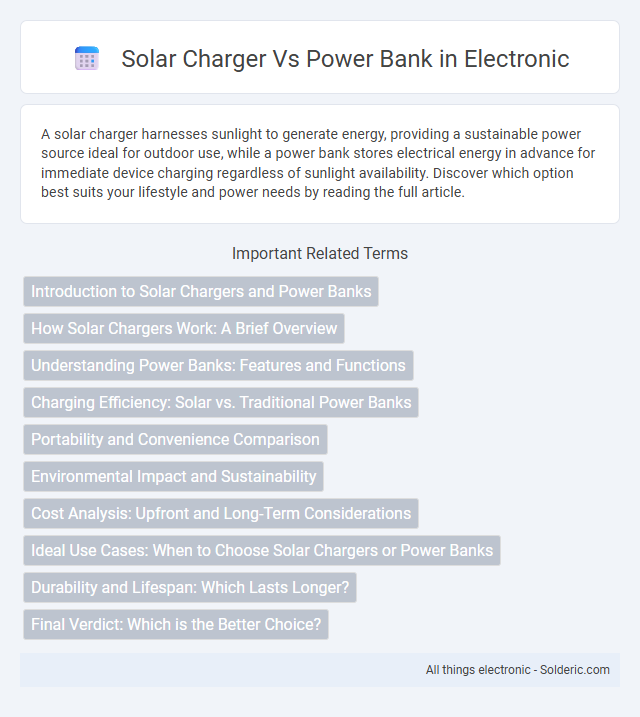A solar charger harnesses sunlight to generate energy, providing a sustainable power source ideal for outdoor use, while a power bank stores electrical energy in advance for immediate device charging regardless of sunlight availability. Discover which option best suits your lifestyle and power needs by reading the full article.
Comparison Table
| Feature | Solar Charger | Power Bank |
|---|---|---|
| Power Source | Solar energy (sunlight) | Pre-charged battery (electricity) |
| Charging Speed | Slow to moderate, depends on sunlight intensity | Fast, instant charging capabilities |
| Capacity | Varies, generally lower (5W-20W panels) | High, ranges from 5,000mAh to 30,000mAh+ |
| Portability | Lightweight, but size varies with panel type | Compact, easy to carry |
| Usage Environment | Outdoor, requires sunlight | Indoor/outdoor, independent of sunlight |
| Cost | Moderate to high, depending on panel efficiency | Low to moderate, based on capacity and brand |
| Environmental Impact | Eco-friendly, renewable energy source | Battery disposal concerns, relies on electricity |
| Best For | Outdoor enthusiasts, emergency solar charging | Everyday portable device charging |
Introduction to Solar Chargers and Power Banks
Solar chargers harness renewable energy from sunlight to charge your devices, making them ideal for outdoor and emergency use. Power banks store electrical energy in internal batteries for quick, portable device charging without relying on sunlight. Choosing between a solar charger and a power bank depends on your access to sunlight and the need for immediate power availability.
How Solar Chargers Work: A Brief Overview
Solar chargers harness sunlight through photovoltaic cells to convert solar energy into electrical power, enabling you to charge devices on the go without relying on conventional electricity sources. These chargers typically include built-in batteries that store energy for use when sunlight is insufficient or unavailable. Understanding the solar conversion process and the efficiency of the photovoltaic cells helps optimize your choice between a solar charger and a power bank based on your charging needs.
Understanding Power Banks: Features and Functions
Power banks are portable battery packs designed to store electrical energy, enabling you to charge your devices on the go without needing an outlet. They vary in capacity, measured in milliampere-hours (mAh), which determines how many charges they can provide, and include features like multiple USB ports, fast charging technology, and built-in safety protections against overcharging and short circuits. Unlike solar chargers, power banks rely on pre-stored electricity and offer consistent power output regardless of sunlight availability, making them reliable options for keeping your devices powered anytime.
Charging Efficiency: Solar vs. Traditional Power Banks
Solar chargers rely on sunlight to convert energy, resulting in slower and less consistent charging efficiency compared to traditional power banks that store electrical energy and provide rapid, reliable power output. Power banks typically offer higher capacity and faster recharge rates, ensuring your devices are charged quickly whether indoors or outdoors. You may find solar chargers beneficial for eco-friendly use and emergency situations, but power banks excel in consistent performance and charging speed.
Portability and Convenience Comparison
Solar chargers provide exceptional convenience by harnessing sunlight to recharge devices on the go, eliminating the need for electrical outlets, making them ideal for outdoor activities and remote locations. Power banks offer superior portability due to their compact size and lightweight design, allowing easy storage in pockets or bags for instant power access anytime. While solar chargers depend on sunlight exposure for efficiency, power banks deliver reliable, consistent energy regardless of environmental conditions, enhancing user convenience in urban and indoor settings.
Environmental Impact and Sustainability
Solar chargers harness renewable energy directly from the sun, significantly reducing carbon emissions and dependence on fossil fuels compared to conventional power banks that rely on electricity generated by non-renewable sources. Unlike power banks, which require periodic replacement and disposal of lithium-ion batteries contributing to electronic waste, solar chargers offer a more sustainable option by minimizing waste and promoting cleaner energy. The environmental impact of solar chargers is markedly lower over their lifecycle, making them a preferable choice for eco-conscious consumers seeking sustainable mobile power solutions.
Cost Analysis: Upfront and Long-Term Considerations
Solar chargers typically have a higher upfront cost due to integrated photovoltaic technology, while power banks are more affordable initially but may require replacement over time. Your long-term expenses for solar chargers can be lower since they harness free sunlight to recharge, reducing dependence on electricity and ongoing charging costs. Power banks, however, depend on electricity consumption for recharging, which adds to cumulative costs depending on usage frequency.
Ideal Use Cases: When to Choose Solar Chargers or Power Banks
Solar chargers are ideal for outdoor enthusiasts, campers, and emergency preparedness, providing sustainable power by harnessing sunlight in remote or off-grid locations. Power banks are better suited for everyday use, travelers, and urban settings where access to electrical outlets allows for easy recharging and fast energy storage. Choosing between them depends on the availability of sunlight, charging speed requirements, and portability needs.
Durability and Lifespan: Which Lasts Longer?
Solar chargers generally have a longer lifespan due to their reliance on durable photovoltaic cells, which can function efficiently for 10 to 25 years with proper care. Power banks, equipped with lithium-ion batteries, typically last 2 to 3 years before battery capacity significantly degrades. Your choice depends on whether you prioritize longevity and eco-friendliness with solar chargers or the convenience and immediate power availability of power banks.
Final Verdict: Which is the Better Choice?
Solar chargers provide eco-friendly, renewable energy ideal for outdoor use and emergencies but often have slower charging speeds and dependency on sunlight. Power banks offer reliable, fast charging with higher capacity, making them suitable for everyday use and extended device power needs. Your choice depends on whether you prioritize sustainability and off-grid charging or consistent, rapid energy replenishment.
Solar charger vs power bank Infographic

 solderic.com
solderic.com